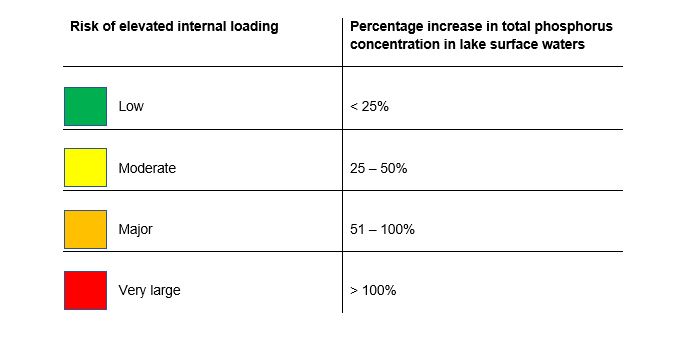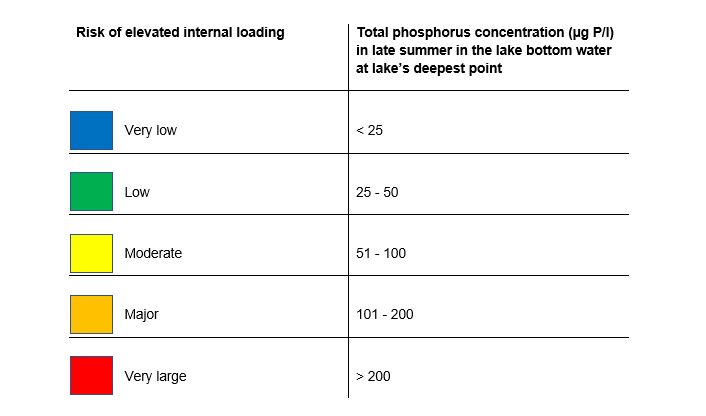This is an appendix to: Huser et al. 2023. Handbook – a decision-support tool for measures against internal phosphorus loading in lakes.
Download pdf-version of appendix 1
Background
The tool has been developed by Brian Huser, Swedish University of Agricultural Sciences, within the framework of LIFE Rich Waters. It is based on environmental monitoring data from reference lakes and eutrophic lakes that were produced within the project, and also from international literature.
Purpose
The tool can be used to indicate the level of risk of the lake being affected by elevated internal loading (i.e., diffusion of phosphorus from the lake’s sediments in addition to the diffusion occurring in a similar unaffected reference lake) on the basis of simple data relating to the concentrations of phosphorus of the lake water.
Assessing the risk of elevated internal loading using the tool
Dimictic, polymictic or mixed lake?
The tool distinguishes between lake types on the basis of whether they are fully or partially stratified in summer, or not stratified at all. That is why it is important to first identify which type the lake belongs to. Dimictic lakes have stable stratification between spring and autumn mixing periods. Polymictic lakes are usually mixed but can be stratified for short periods during the summer. In mixed lakes, the entire water mass remains generally completely mixed throughout the summer. Incorrect identification of lake type usually results in an underestimate of risk for internal loading.
Note that lake type is not always static and may vary from year to year depending on weather conditions. For instance, it is not uncommon for lakes to be dimictic in some years but polymictic in others. Similarly, incomplete mixing means that lakes where the water column mixes may demonstrate much higher phosphorus levels in bottom waters than in surface waters in some years and are then polymictic. Therefore, a lake type assessment must always be performed for each sampling year, if sufficient data are available. This is why reference is sometimes made to the stratification conditions of a lake instead of the lake type, in order to emphasise that the lake may have different stratification conditions from year to year. Appendix 2 describes how to identify the lake type.
Completely mixed lakes with no stratification
In mixed lakes, the risk of internal loading is assessed by comparing the lowest phosphorus concentration value measured in the lake between late winter and early summer (February to June), with the highest value in late summer or early autumn (August to early September). The percentage increase in phosphorus concentration between these dates is then used to calculate the risk for elevated internal loading. The risk is based on a 4-point scale as described in Table 1 below.

Sources of incorrect assessment of risk
Miscalculation of lake type
It is important that the lake is fully mixed when samples are taken. The samples taken in late summer present the greatest risk that the lake may not be fully mixed. If data for the phosphorus level in both surface water and bottom waters are available, these data can be used to verify whether the lake is fully mixed. The temperature and oxygen content of the bottom water in late summer can also be used to make this assessment reliably. Finally, the Osgood index of the lake or its maximum depth can be used, but this method is less reliable (see Appendix 2 for more details).
Lakes covered with ice
In many lakes, a clear water phase with low phosphorus concentrations occurs in late spring or early summer and is generally the most suitable sample to use as part of the analysis. At that time, zooplankton have greatly reduced the amounts of phytoplankton while there is no or only very little internal loading. In lakes that were covered with ice, the impact of internal loading that occurred during the winter has also been greatly reduced at that time. If spring samples in ice covered lakes, however, taken immediately after the ice out and spring mixing are used in the analysis (February to April in southern and central Sweden, May in northern Sweden) there is a risk that the phosphorus concentrations in the samples are elevated due to winter internal loading and do not correspond to the minimum level before summer. If this concentration is then compared with the concentration in late summer, the difference may be negligible or even negative and lead to an incorrect assessment of low risk. The risk of internal loading is then underestimated.
Influences from external sources
The risk assessment is based solely on measurements of phosphorus concentrations in the lake and does not take into account the potential impact of external loading. External loading from diffuse sources can be high immediately after intensive rainfall events or during spring runoff caused by snow melt, and if this has occurred shortly before lake samples were taken it may lead to an incorrect risk assessment. In particular, lakes with a short turnover time (< 1 month) have a higher risk of being affected by external loading.
Dimictic lakes with stable stratification throughout the summer period
The risk of elevated internal loading in dimictic lakes is assessed using a 5-point scale. It is based on the phosphorus concentration of the lake bottom water (1 m above the sediment) in late summer (late July to early September, before mixing) according to the categories in Table 2 below.

The risk assessment of dimictic lakes is normally quite certain providing there is sufficient data to assess stratification conditions in the lake when samples in late summer were taken (see Appendix 2).
Polymictic or intermittently stratified lakes
In polymictic lakes, the risk of elevated internal loading is assessed using both the method for fully mixed lakes and the method for dimictic lakes. The final risk assessment is based on the method that shows the greatest risk for elevated internal loading. However, both assessments will usually underestimate the actual risk. It is not possible to specify exactly how great the underestimation will be, but in many cases it can be assumed that the risk may be one level higher than indicated in the tables.
However, in cases where the temperature or phosphorus profile shows that the lake is fully mixed when taking samples in late summer, a risk assessment can be done using the method for fully mixed lakes. This is even the case if the lake was partially stratified prior to late summer sampling.


